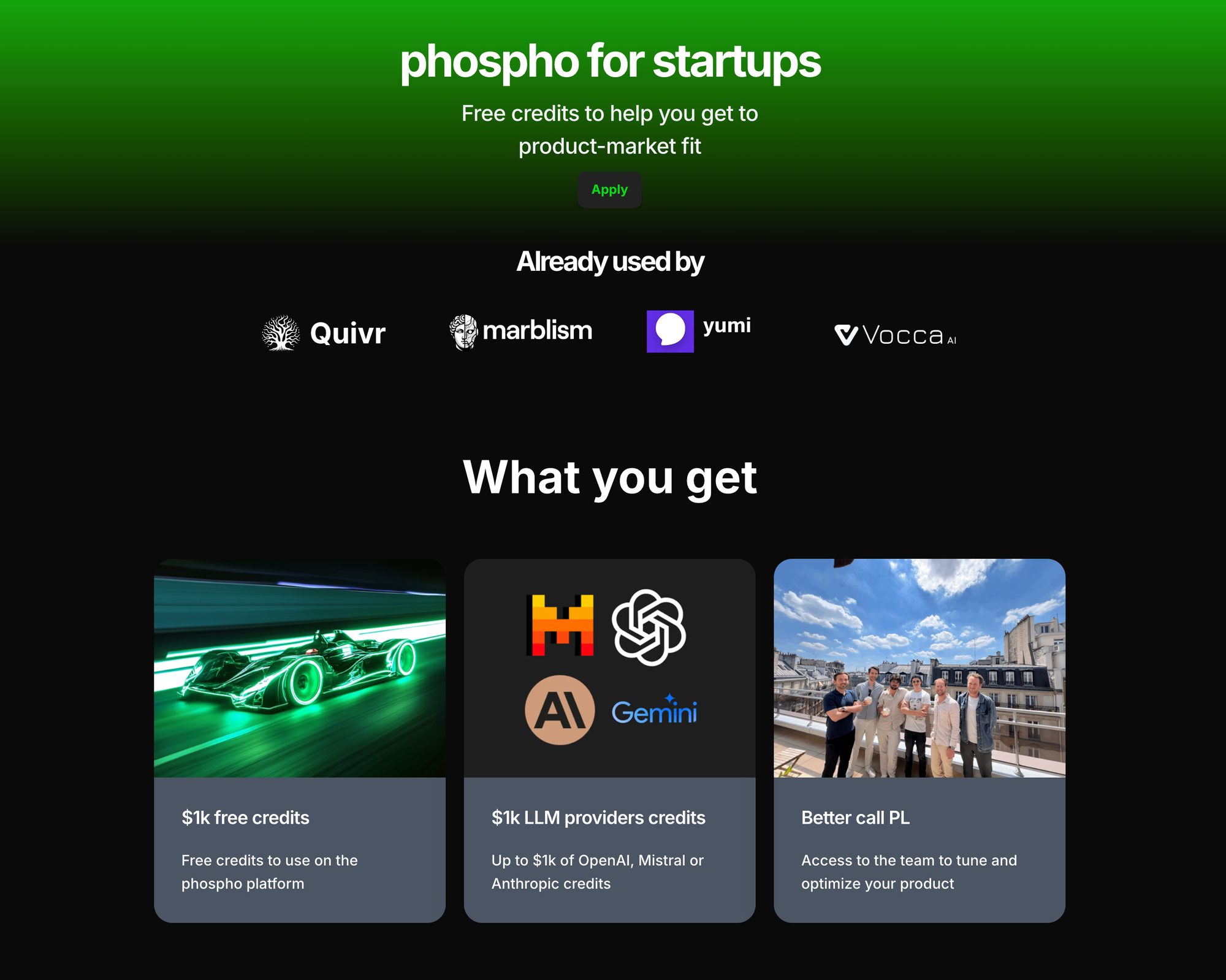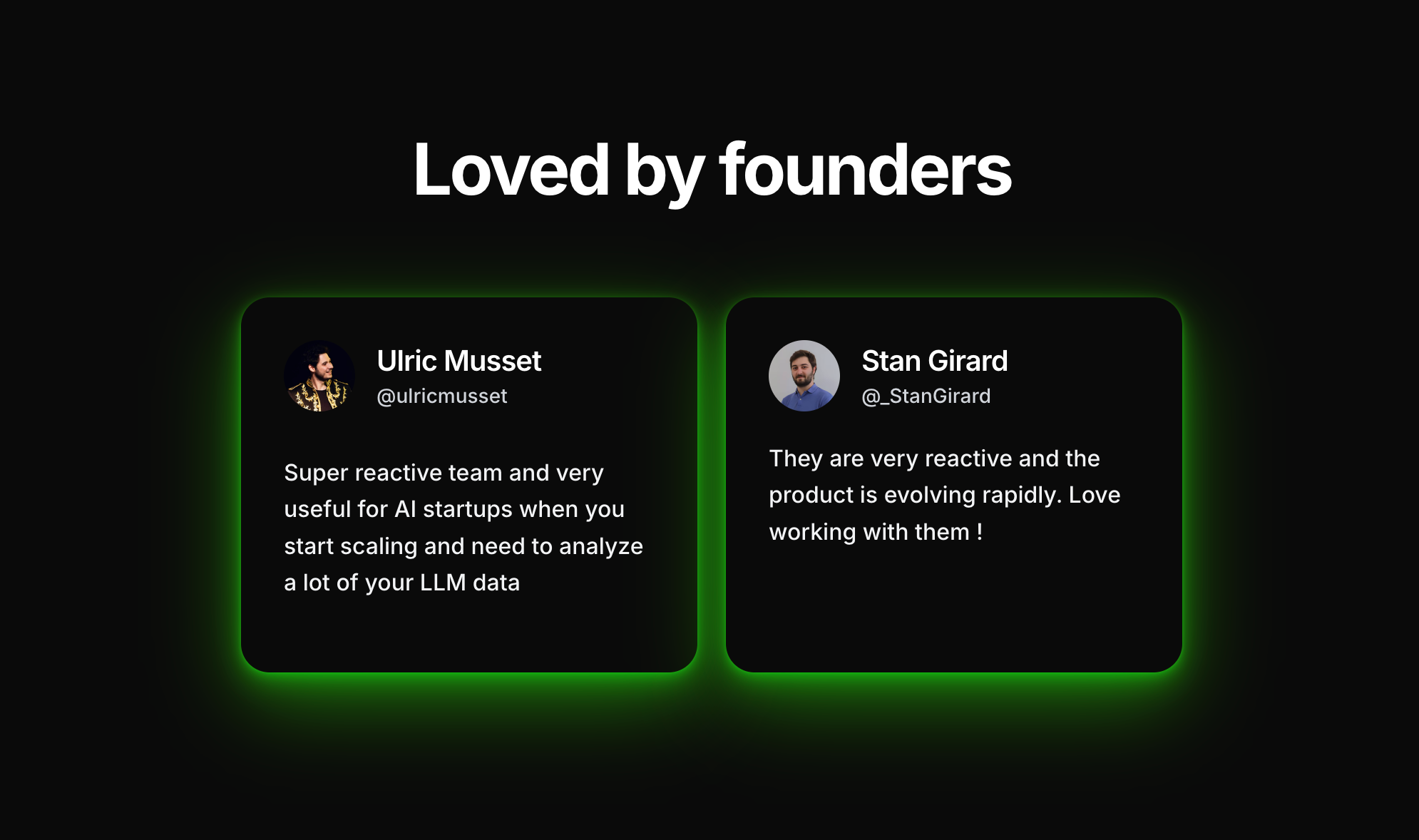Phospho Startup Program: Get $2000 AI Builder Credits for Free (Find PMF with Your AI SaaS Faster)
Phospho’s startup program offers early-stage AI SaaS developers $2000 in AI builder credits, supporting innovation through affordable experimentation and reduced financial risk.

Introducing an offer you won’t want to miss…
We provide a free program for startups that grants $2000 in AI builder credits. You can use these credits with other AI providers and on Phospho’s analytics platform.
If you’re an early-stage AI SaaS startup or a developer looking to accelerate your product development journey, this could be the opportunity for you.
This promotion is limited and will be offered on a first-come, first-serve basis – so if you’re keen, get your application in now.
Get Your $2000 Free AI Builder Credits
AI builder credits help startups by reducing financial barriers to innovation, allowing for more experimentation and fewer risks.
With more financial freedom to iterate, AI builder credits will have paved a more efficient path to finding your product market fit (PMF).
We don’t need to tell you that today’s AI landscape is competitive and fast-paced, making quick experimentation and adaptation crucial for SaaS startups that want to scale.
It can cost between $20K and $1M for SaaS companies to train AI models, but you can cut this price tag substantially with our $2000 free AI builder credits.
Want the freedom to experiment without the financial pressure? Sign up for our startup program today.
Why Apply to the AI SaaS Startup Program?
Phospho Encourages Data-Driven Iterations
If you’re building and training an AI model, it’s important to incorporate analytics from the start.
If you apply to Phospho’s startup program, you can use our platform to monitor, learn and iterate based on real-time user interactions with your products. This will help you improve and scale your product faster and without huge financial expenditure.
We know that data-driven iteration cycles can drastically reduce the time and resources needed to achieve product market fit by helping you focus on what’s really important – building a product that your users love, and that has a valuable place in the AI market.
AI Builder Credits Reduce Financial Risk
The need for upfront investment prevents many SaaS startups from ever achieving product market fit or reaching the scaleup phase. We think technical innovation should be open to all, which is why we want to help new startups and product developers get their ideas off the ground.
Our $2000 free AI builder credits will help you focus on product development without worrying about the financial pressure or risks associated with investment or loans.
You’ll Have Freedom to Experiment
We know that AI builder credits empower startups to create their best possible products – to empower frameworks, test different models and try various algorithms without worrying about escalating costs.
This level of experimental freedom will ultimately lead to faster innovation cycles, helping you find your unique selling point quicker, and without financial worries.
Early Experimentation Could Lead to Higher ROI
Early experimentation with AI models leads to higher chances of achieving PMF and scaling up effectively. Research shows that startups that embrace rapid experimentation at an easy stage typically reach product market fit much faster than those who don’t – just another reason to join our program.

How to Use AI Builder Credits to Reach Product Market Fit: Test Different AI Models
Try Different AI Providers
As part of our Startup Program, you can test out different AI models – such as OpenAI, Mistral, Cohere and more – for free, to see which best fits your product.
Trying out different AI providers in the early stages will help you iterate faster and iron out any problems you have with your models, as well as learn how to get the best out of them. A range of AI providers can be accessed using our AI builder credits
Experiment with Model Architectures
Similarly, you may want to test models with different parameters, such as GPT-3.5, LLaMA or smaller fine-tuned models to find the ultimate best fit for your use case.
It’s helpful to try out different model architectures at the startup stage to allow deep learning engineers to iterate more quickly.
Use Phospho to Track Results and Feedback
You can use our platform to log AI model inputs and outputs and then compare them to see which works best. It’s also easy to set up controlled experiments to check which AI model or prompt performs best in real-world scenarios.
Phospho also lets you gather and action user data and feedback in real time using our Linking feature, which is probably the most important iteration tool in refining AI models.
Data from your real-world users will help you better tailor your AI model to meet your users’ unique needs and preferences. For example, if you’re building an AI ecommerce platform, using real-world user feedback will allow you to fine-tune the model to deliver more relevant product recommendations.
Set Up Analytics for Better Iteration Cycles
Monitor User Interactions
As before, it’s incredibly important to monitor user behavior in real-time so you can respond to it and include the feedback in iteration cycles. It’s also crucial to track the performance of your AI model so you can effectively detect patterns and edge cases.
Automate Insights Detection
Our automated insights detection will help you to understand your user needs and problems without delay, so you can get on with building and testing the best possible product and finding your market fit.
Set KPIs for Your AI SaaS Product
You can use Phospho to set custom KPIs for your AI SaaS product, such as response accuracy, latency, user retention or satisfaction scores. This will help you monitor your progress toward your goals and hit your key performance indicators. You can also change your KPIs as you scale and evolve.
Detect and Address Vulnerabilities
Our $2000 free AI builder credits will let you test your product more frequently, so you can flag and address any weaknesses in your system and eliminate them. This will help you refine and improve your product faster and will boost user satisfaction.
Compare Different Model Versions
You can use analytics to understand how updates to your AI models or prompts impact user engagement and overall performance, helping you find the right model version for your application.
Identify Key Metrics on Your Journey Toward PMF
Engagement Metrics
On your journey to finding product market fit, it’s important to regularly monitor metrics like user retention rates, session lengths and active user counts. This is so you can check how your users are using your product and use the feedback for future iteration cycles.
For example, if you find that users aren’t spending very long on a specific page or part of your application, you might take steps to make that page more engaging by including different forms of media or changing the interface.
Customer Acquisition Cost vs Lifetime Value
Reducing the cost of acquiring customers (or Customer Acquisition Cost – CAC) while increasing your Lifetime Value (LV) is a strong sign that your product is moving closer to product market fit, so it’s important to regularly monitor these metrics and make tweaks when necessary, both to lower your CAC and improve LV for your users.
Churn Rate
Churn is when a user leaves your company or navigates away from your product. There are a number of reasons why this can happen, such as a poor user interface, slow loading speed, poor quality service, ineffective marketing or a competitor product.
It’s important to analyze your churn rate over time so you can minimize it. A low churn rate indicates that your product is aligning with market needs.
Performance Metrics
You should also pay attention to model-specific performance metrics, such as F1 score (an important metric for evaluating classification models), accuracy and response time to make sure your model is working effectively. These metrics will all affect user satisfaction and churn rates, so don’t forget to track them.
User Feedback Trends
Lastly, there are few things more important in the startup stage than collecting and acting on user feedback. Positive user feedback and high satisfaction scores are qualitative signs that you’re reaching your product market fit, while negative and constructive feedback highlights areas of your product you need to improve.
How to Make the Most of Your AI Builder Credits
To make the most of your AI builder credits, we recommend that you start small and scale gradually – a phased approach is often best for testing AI models, so begin with smaller projects or particular use cases, then you can expand based on successful results.
That said, you should also be thinking about how you’ll scale your infrastructure over time, while continuously tracking your AI model’s performance by gathering relevant and diverse data.
It’s also important to regularly reassess your KPIs. They should be flexible and change as you receive new insights from data analysis and customer feedback loops.

Join Phospho’s AI SaaS Startup Program Today!
Take advantage of Phospho’s free startup program, and collect your $2000 AI builder credits. You’ll benefit from our early integrations, such as Python, JavaScript, CSVs and other common data pipelines.
If you’re an early-stage AI SaaS startup or developer looking to scale, this program won’t just help you in the short term – it will also help set you up for sustainable growth with a data-driven approach.
Sign up for Phospho’s free program today to kickstart your journey toward product market fit and future-proof your startup.
